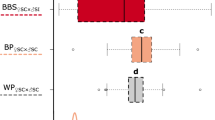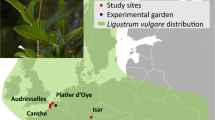Summary
An alternative to the classical model of self-incompatibility indicates that genetic control of self-incompatibility could involve more than one locus and function through passive failure of incompatible pollen tubes rather than through their active inhibition. Both aspects of the alternative model have been tested and, in each case, the data support the classical single-locus oppositional interpretation rather than the alternative. On the basis of these data, and others now available, we conclude that, in the Solanaceae, and presumably also in some others, self-incompatibility is better explained by the classical interpretation. Several points, however, remain to be resolved.
Similar content being viewed by others
References
Anderson MA, Cornish EC, Mau S-L, Williams EG, Hoggart R, Atkin A, Bonig I, Grego B, Simpson R, Roche PJ, Haley JD, Penschow JD, Niall HD, Tregear GW, Coghlan JP, Crawford RJ, Clarke AE (1986) Cloning of cDNA for a stylar glycoprotein associated with expression of self-incompatibility in Nicotiana alata. Nature 321:38–44
Ellstrand NC, Marshall DL (1985) Interpopulational gene flow by pollen in wild radish. Am Nat 126:606–616
Gibbs PE (1986) Do homomorphic and heteromorphic self-incompatibility systems have the same sporophytic mechanism? Plant Syst Evol 154:285–323
Hewlett BJ, Knox RB, Paxton JB, Heslop-Harrison J (1975) Pollen-wall proteins: physiochemical characterization and role in self-incompatibility in Cosmos bipinnatus. Proc R Soc London Ser B 188:167–181
Larsen K (1986) Cell-cell recognition and compatibility between heterogenic and homogenic incompatibility. Hereditas 105:115–134
Lawrence MJ, Marshall DF, Curtis VE, Fearon CH (1985) Gametophytic self-incompatibility reexamined: a reply. Heredity 54:131–138
Martin FW (1961) The inheritance of self-incompatibility in Lycopersicon esculentum Mill. L. chiliense Dun. Genetics 46:1443–1454
Mulcahy DL, Mulcahy GB (1983) Gametophytic self-incompatibility reexamined. Science 220:1247–1252
Mulcahy DL, Mulcahy GB (1986) Gametophytic self-incompatibility: a test of the heterosis model. In: Cresti M, Dallai R (eds) Biology of reproduction and cell motility in plants and animals. University of Siena, Siena, pp 33–40
Mulcahy DL, Mulcahy GB, MacMillan D (1986) The heterosis model: a progress report. In: Mulcahy DL, Ottaviano E, Mulcahy GB (eds) Biotechnology and ecology of pollen. Springer, Berlin Heidelberg New York, pp 245–250
Nasrallah ME, Nasrallah JB (1984) Electrophoretic heterogeneity exhibited by the S-allele specific glycoproteins of Brassica. Experientia 40:279
Nishio T, Hinata K (1977) Analysis of S-specific proteins in stigmas of Brassica oleracea L. by isoelectric focusing. Heredity 38:391
Olmstead RG (1986) Self-incompatibility in light of population structure and inbreeding. In: Mulcahy DL, Ottaviano E, Mulcahy GB (eds) Biotechnology and ecology of pollen. Springer, Berlin Heidelberg New York, pp 239–244
Seavey SR, Bawa KS (1986) Late-acting self-incompatibility in the angiosperms. Bot Rev 52:195–220
Tanksley SD, Loaiza-Figueroa F (1985) Gametophytic self-incompatibility is controlled by a single major locus on chromosome 1 in Lycopersicon peruvianum. Proc Natl Acad Sci USA 82:5093–5096
Vander Kloet SP, Lyrene PM (1987) Self-incompatibility in diploid, tetraploid, and hexaploid Vaccinium corymbosum. Can J Bot 65:660–665
Visser T, Verhaegh JJ (1980) Pollen and pollination experiments. II. The influence of the first pollination on the effectiveness of the second one in apple. Euphytica 29:385–390
Author information
Authors and Affiliations
Rights and permissions
About this article
Cite this article
Mulcahy, D.L., Mulcahy, G.B. Tests of the heterosis model. Sexual Plant Reprod 1, 32–35 (1988). https://doi.org/10.1007/BF00227020
Issue Date:
DOI: https://doi.org/10.1007/BF00227020




